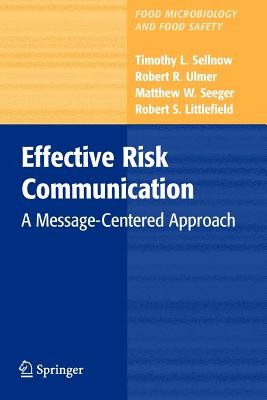
- We will send in 10–14 business days.
- Author: Timothy L Sellnow
- Publisher: Springer
- ISBN-10: 1441927255
- ISBN-13: 9781441927255
- Format: 15.6 x 23.4 x 1.1 cm, softcover
- Language: English
- SAVE -10% with code: EXTRA
Reviews
Description
Coordination of risk assessments and risk communication strategies requires information sharing and establishing networks of working relationships between groups and agencies. Establishing these relationships necessitates overcoming - stitutional, cultural, and political boundaries. Signi?cant barriers exist between r- ulatory agencies and industry groups. Traditionally, these groups have mistrusted one another, and cooperation and collaboration, including sharing information, c- respondingly has been limited. The adoption of radio frequency identi?cation te- nology for tracking livestock, for example, has been met with signi?cant resistance due in part to mistrust between regulatory agencies and producers (Veil, 2006). In the food industry, the need for coordination has been enhanced by industry in- gration and globalization of both markets and production. In the case of GM foods discussed earlier, disagreements between U. S., European Union, and Canadian r- ulatory agencies fueled the debate over the safety of GM crops. Overcoming institutional and cultural barriers, and mistrust is necessary to create consistency in risk messages. Open communication and information sharing can help clarify where risk perceptions diverge and identify points of convergence. The outcome may not be universal agreement about risks, but convergence around the general parameters of risk. Summary These best practice strategies of risk communication are not designed to function as distinct steps or isolated approaches. Rather than being mutually exclusive, they serve to complement one another and create a coherent approach to confronting risk communication problems.
EXTRA 10 % discount with code: EXTRA
The promotion ends in 16d.16:17:20
The discount code is valid when purchasing from 10 €. Discounts do not stack.
- Author: Timothy L Sellnow
- Publisher: Springer
- ISBN-10: 1441927255
- ISBN-13: 9781441927255
- Format: 15.6 x 23.4 x 1.1 cm, softcover
- Language: English English
Coordination of risk assessments and risk communication strategies requires information sharing and establishing networks of working relationships between groups and agencies. Establishing these relationships necessitates overcoming - stitutional, cultural, and political boundaries. Signi?cant barriers exist between r- ulatory agencies and industry groups. Traditionally, these groups have mistrusted one another, and cooperation and collaboration, including sharing information, c- respondingly has been limited. The adoption of radio frequency identi?cation te- nology for tracking livestock, for example, has been met with signi?cant resistance due in part to mistrust between regulatory agencies and producers (Veil, 2006). In the food industry, the need for coordination has been enhanced by industry in- gration and globalization of both markets and production. In the case of GM foods discussed earlier, disagreements between U. S., European Union, and Canadian r- ulatory agencies fueled the debate over the safety of GM crops. Overcoming institutional and cultural barriers, and mistrust is necessary to create consistency in risk messages. Open communication and information sharing can help clarify where risk perceptions diverge and identify points of convergence. The outcome may not be universal agreement about risks, but convergence around the general parameters of risk. Summary These best practice strategies of risk communication are not designed to function as distinct steps or isolated approaches. Rather than being mutually exclusive, they serve to complement one another and create a coherent approach to confronting risk communication problems.


Reviews